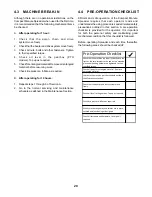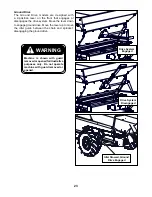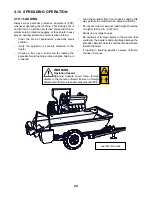
13
2�11 MANURE SPREADER SAFETY
1. BEFORE unclogging, cleaning, adjusting, lubricating
or servicing, but the spreader into
Safe Condition
:
•
Shut off hydraulics or mechanical drive.
•
Shut off the engine.
• Ensure all components have stopped moving.
• Set the parking brake.
• Remove and pocket the ignition key.
2.
A tractor or loader scraping or dumping at a push-off
ramp could slide over the edge of the ramp. This
might happen because of operator error, mechanical
failure, or simply a too-slick surface. This can result
in fatal crushing or entrapment of the operator.
3. Use caution when loading the manure spreader with
a skid steer or tractor, be aware of objects around
you and any by standers. Never exit a tractor or skid
steer with the bucket raised.
2�10 TRANSPORT SAFETY
1. Comply with state and local laws governing safety
and transporting of machinery on public roads.
2. Always adjust the driving speed to suit the driving
conditions. Avoid fast turning when driving uphill,
downhill or across a slope.
3. Braking performance and turning ability will be
affected when spreader is loaded and hitched to
the tractor - allow extra time for turning and braking
4. Be sure machine is hitched positively to the tractor
and a retainer is used through the mounting pins.
5. Do not drink and drive.
6. Be a safe and courteous driver. Always yield to
oncoming traffic in all situations, including narrow
bridges, intersections, etc. Watch for traffic when
operating near or crossing roadways.
7. Never allow riders on the machine.
8. The use of a slow moving vehicle sign is required
unless equipped with flashing hazard lights. Obey
all applicable highway safety laws and rules.
9. Do not exceed a safe travel speed when
transporting. Use safety chain around hitch and
drawbar cage to prevent unexpected separation.
10. Maintain proper tire air pressure at all times,
check wheel nuts on a regular basis and torque as
required.
4. Do not load the spreader unless it is hitched to the
tractor and do not unhitch a loaded spreader from
the tractor leaving it supported by only the jack.
5. Be sure there is plenty of ventilation in the loading
area, gases produced by decomposing manure
in storage can be fatal.
6. Verify safety shields are in place, moving parts
on manure spreaders, such as power take-off
drivelines, side shafts, pulleys and sprockets are
hazardous if not shielded. Becoming entangled
in unshielded rotating shafts may result in am-
putations, spinal injuries and death.
7. Always remove loose manure or soil from tires
and other parts of the equipment before enter-
ing the roadway. Manure or wet soil left on the
roadway by your tractor and spreader is a hazard
to other vehicles.
8. Do not allow anyone within 20 ft (6 m) of the
spreader during operation. Objects thrown from
the rear of the spreader could cause injury.
9. Do not use a tractor unless it is equipped with
a ROPS.
10. Never operate any controls from the ground.
Remain seated to while operating machinery.
It is extremely dangerous to attempt to make
adjustments around the spreader when it is
operating. Spinning beater paddles, and other
moving parts can cause injury or death.
11. Do not attempt to scape or clean the inside of the
spreader when the PTO is engaged. Falling into
spinning paddle of the spreader could be fatal.
12.
When finished spreading, park your spreader
on level ground and place blocks ahead of and
behind the wheels before unhooking. This will
prevent unexpected rolling of the spreader when
separated from the tractor.














































